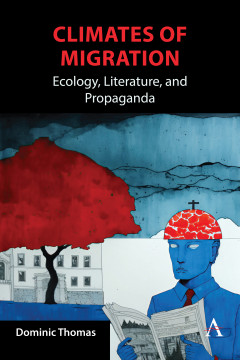Climates of Migration
Ecology, Literature, and Propaganda
By Dominic Thomas
- About This Book
- Reviews
- Author Information
- Series
- Table of Contents
- Links
- Podcasts
About This Book
The prologue and chapter 1 situate the discussion in Climates of Migration in a broader context defined by a resurgence of attention on colonialism and postcolonial legacies, as evident in debates on restitution, reparation, historical accountability and responsibility. Colonial exploration and conquest are thereby connected with the environmental–migration nexus and accordingly chart the coordinates of the book as readers navigate the tentacular planetary reach of European colonial powers. This was of course an era when overseas travel was not even an option for the majority of people, yet one defined by sophisticated propagandist mechanisms that encouraged Europeans to travel through the imagination thanks to the immersive experiences offered at World’s Fairs and Colonial Exhibitions as well as in various board games and other ephemera that promoted the benefits of having colonies, glorified conquest and expansion, while molding young minds and bolstering patriotic fervor. The lessons to be learned were manifold, concerning as they did a recognition of the importance to the economy of—and dependency on—colonies, while implanting a deep familiarity with goods and products. These games capitalized upon the experiential realities of colonial assignments, and the design replicated the defining elements of the colonial enterprise, while also of course mobilizing support. Yet, as we know today, agricultural and extraction practices contributed to anthropogenic global warming, as communities were removed or driven off their lands, displaced and compelled to migrate elsewhere. As such, questions of mobility were therefore central to the production and visualization of Empire, and today, heated debates pertaining to border control and sovereignty can be traced back to this era.
The catalyst for chapter 2 is to be found in French philosopher Bruno Latour’s statement whereby “We can understand nothing about the politics of the last fifty years if we do not put the question of climate change and its denial front and center.” The focus thus shifts to the multiple ways in which climate change has bent the arc of politics in new directions, most notably in the conjunction between the eco-colonial dimension and migration itself given that “What makes the migratory crisis so difficult to conceptualize is that it is the symptom, to more or less excruciating degrees, of an ordeal common to all: the ordeal of finding oneself deprived of land.” Extensive recourse has been made to climate metaphors to amplify anti-immigration rhetoric, collectively delineating the parameters of an invasion narrative that alleges cultural, political and social saturation, submersion and replacement. Recourse to such terminology to describe migration exploits a simple tautology: climate change is a negative development, and therefore, conflating metaphors allows for a seamless twinning with the ills of immigration, grafting a pernicious meaning on the process (migration) and people concerned (migrants). In the associative context of climate change, this logic operates optimally since it coincides with a diagnosis of catastrophic global warming and the long-term projected impact, and has been present in European Union policy-making (“Green Deal” and “New Pact on Migration and Asylum of the EU”) and broader discussions pertaining to climate migrants and climate refugees.
Two strands intersect in chapter 3 and build on the conclusions of the previous chapters, simultaneously reappraising the coexistence of insular and open thinking and complex and simplistic reasoning and shifting the discussion toward an engagement with categories such as empathy and sympathy. This is achieved through a consideration of how cultural productions by artists and writers have enhanced modes of identification and relationality rather than detachment, and offered alternatives to racist and xenophobic media and political discourses. Chapter 4 subsequently provides an in-depth analysis of an emerging corpus of works by African writers for whom transhistorical violence motivates political commitment based on scrutiny and witnessing, documenting, recording and calls for accountability. The works considered have in common an adherence to an “environmental turn” that has culminated in a thematic “greening” of fiction (Cheryll Glotfelty) and a revitalization of writing. Writers have engaged with the longstanding consequences of environmental ecocide on the continent, while ultimately reflecting on the broader context of climate change and environmental derangement that accounts for shifting patterns of population mobility. The concluding chapter establishes a conjunction between new technologies of communication and extraction, more prominently in terms of the interplay between ecology and propaganda, and examines how the later has been used to further an anti-ecological agenda—denouncing warnings concerning global warming as fake news or promoting a lifestyle founded on the exponential use of industrial technologies—and pro-ecology positions centered on an unrelenting effort to prevent the systematic destruction of the environment and aimed at raising awareness and consciousness as well as encouraging behavior modification. The conclusion considers how new digital technologies have taken an age-old apparatus and amplified it, enabling information wars to run alongside physical ones, while discussing how disinformation and misinformation campaigns and algorithms now influence every facet of contemporary life, most prominently in terms of the climate change and migration nexus.
Reviews
Author Information
Series
Table of Contents
Links
Stay Updated
Information
Latest Tweets



